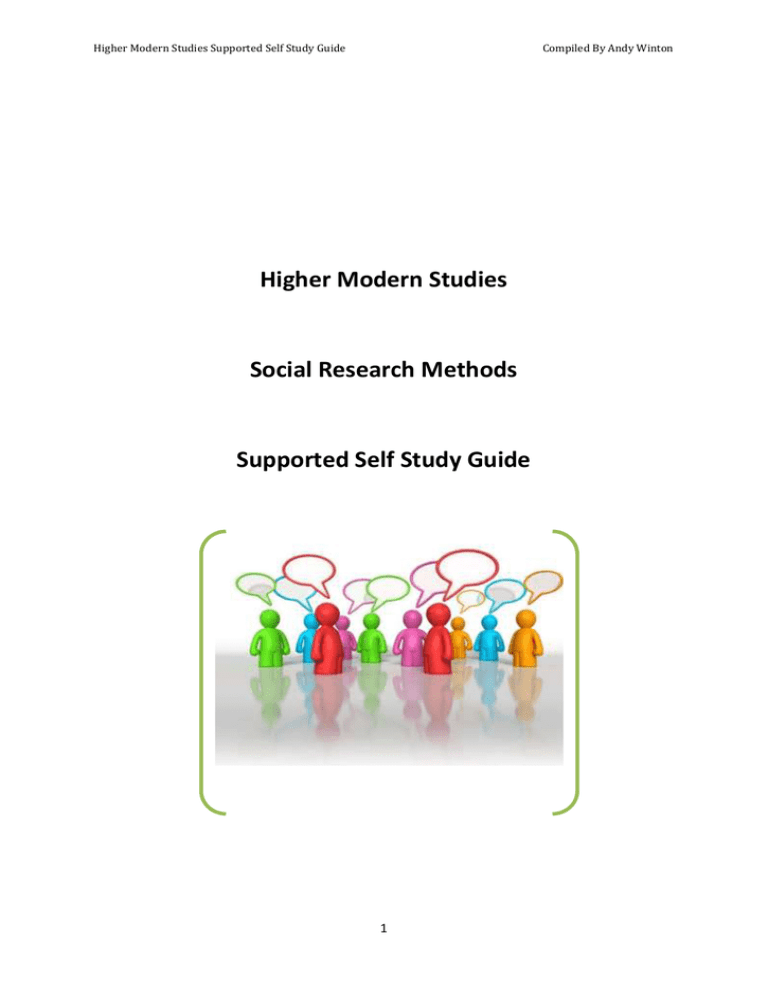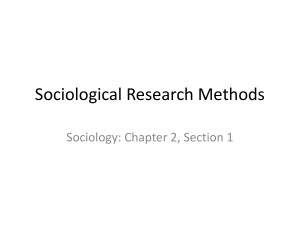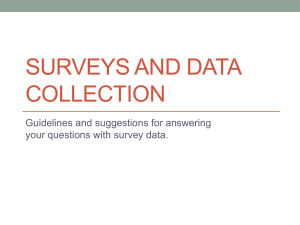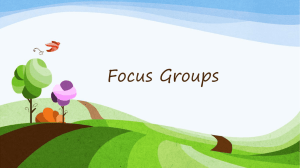Higher Modern Studies Supported Self Study Guide Compiled By
advertisement

Higher Modern Studies Supported Self Study Guide Compiled By Andy Winton Higher Modern Studies Social Research Methods Supported Self Study Guide 1 Higher Modern Studies Supported Self Study Guide Compiled By Andy Winton Pupil Notes: You should keep this Guide safe as you will have to refer to it as you carry out your Assignment later in the Higher Course. As part of your Assignment you will be expected to use at least two different Social Research Methods in the research stage. This will require that you 1. Know why you chose the particular methods and their advantages and disadvantages, and 2. Be able to write up how your actual research using these methods was successful or not In this guide there are opportunities for you to practice some of the research skills. You are expected to take much of the responsibility for completing tasks outlined in this guide. However, some class time will also be given over to cover aspects of some of the methods and your teacher will expect to be able to check your progress in completing the tasks set in this guide. Class time will also give you the opportunity to clarify any points you are unsure about. Although you will not get a question based directly on the Research Methods in the Final Examination Paper, a good knowledge and understanding of some of them is vital if you are to carry out and write up what is necessary for the completion of your Assignment – which is a major part of your overall Examination. An understanding of the Research Methods may also help you to analyse some aspects of source based questions in the examination. How to Use this Guide 1. Read the information about each of the Research Methods covered in this Guide. There are other social research methods that could be used but the ones in this guide are the ones that you realistically could choose from for your own research in the Higher Course Assignment. 2. At the end of each research method there are questions to test your knowledge and understanding of the method. There are also tasks set to allow you to build up the skills required to carry out research using the method. 3. As you work through the guide note any points you are unsure about and ask your teacher when class time is given to learning about the research methods. 2 Higher Modern Studies Supported Self Study Guide Compiled By Andy Winton Primary and Secondary Methods Information that is collected by you – not simply re-using what others have found out - is known as Primary Data. Information you use - but has been collected and reported by others - is known as Secondary Data. Both types of data can be useful for your research. Primary data Secondary Data Surveys, questionnaires Formal interviews Informal and unstructured interviews Government statistics Analysis of statistics provided by governments Analysis of research provided by others Study of official documents Analysis of media reports / internet sources Quantitative research aims to collect facts and figures – much superficial information e.g. Surveys using questionnaires using closed questions (Primary) Case studies (Primary) Analysis of statistics (Primary and Secondary) Study of other documents and records (Secondary) Qualitative research aims to gain a more in-depth understanding of the subject – quality information e.g. Informal and unstructured interviews (Primary) Analysis of media (Secondary) Analysis of research carried out by others (Secondary) Primary and Secondary sources of information Primary Data Advantages The researcher is in control of how the information is gathered The researcher can ensure that specific questions are asked The researcher can amend and modify the research if necessary o The researcher can use pilot studies which will help find the best form of wording for questions. o The researcher should be able to ascertain any bias in the sources of information and adjust results accordingly Disadvantages Primary research is time consuming and costly Qualitative methods will tend to be biased 3 Higher Modern Studies Supported Self Study Guide Compiled By Andy Winton Secondary Data Advantages Saves times and money as research is already available Can provide information not easily found elsewhere Disadvantages The reliability is questionable, as you cannot usually check this Other peoples’ research may be biased Purpose behind the research could be different therefore it may not meet your requirements Could be time-consuming to sift through a large amount of information The research methods we will be studying in this guide will be: Surveys, Questionnaires, Interviews – Structured and Unstructured – (these are all Primary Methods) and Media / Internet / Official Statistics Analysis (Secondary Methods) _______________________________________________________________________ Task1: 1) Think of a Modern Studies Topic you have studied in the past two years. 2) For the topic you choose, would you be able to carry out a primary research method to investigate this topic? If so which method? What difficulties might there be in carrying out your research using this method? 3) Would using secondary research only be a viable way to research the topic? 4) What would the advantages be of using a mixture of both primary and secondary research? 5) List 3 topics or issues in Modern Studies where you think using a primary method might be possible for you to adopt if chosen as your Assignment Topic. [Think local, national or international] 6) List 3 topics where you feel secondary methods would have to be used to research them. [Think local, national or international] _______________________________________________________________________ 4 Higher Modern Studies Supported Self Study Guide Compiled By Andy Winton A. Unstructured Interviews The Aim of this method is to get detailed information from the people interviewed. The success or otherwise of this method will be influenced by time and cost and the type of information required, for example, if there is a need for in-depth information about social behaviour. Key features It is a primary source of information and provides qualitative data. Questions are not necessarily pre set It could start with prepared structured questions but then is flexible The researcher can cover a broad range of issues Questions are open ended which allows for in-depth answers and new points to be made Can use a tape recorder Sample number will be smaller than for a survey Advantages It has a good response rate Can examine motivation, opinions and attitudes not just facts When there is rapport between researcher and respondent it helps get close to peoples’ experiences and provides honest responses Researcher is not restricted to a fixed set of questions Provides in-depth information Allows the researcher to clarify points and further explore particular points It also allows the respondent to provide new information that the researcher has not considered If the interview is taped, it makes it easy to analyse the information Disadvantages Can sometimes be hard to maintain the focus of the interview Open to bias as the researcher can easily influence the respondent’s replies e.g. by giving non-verbal clues Some people may not agree to be interviewed so the sample could be composed of like minded people It is difficult to ensure objectivity when the questions are not standardised It is difficult to repeat the research so there are questions about the reliability of the research Can be time-consuming and expensive It takes a lot of skills to be an effective interviewer Leads followed during the interview may also be biased Samples are too small to get information that can be quantified It is possible that the interview could lead to a change in behaviour 5 Higher Modern Studies Supported Self Study Guide Compiled By Andy Winton B. Structured Interviews The aim of these is usually to get factual information. It is best suited for gathering fairly superficial but quantitative information (compared to unstructured interview) Key features This method usually involves face to face interviews where a pre-set list of questions is used which require a limited response but could be done via phone or internet It is like a questionnaire but is face to face It is a primary source providing quantitative data Questions need to be clear and unambiguous Advantages It is good for gaining factual information Results are easy to quantify It gets a good response rate as it is an interview situation It is cheap and if a short questionnaire is used fairly quick method of collecting data Respondents can ask for clarification so it is a reliable method of collecting data Standardised questions mean that there is little opportunity for the researcher to influence the answers so the research should be unbiased It has validity as the results can be checked by other researchers Standardised questions allow analysis to be done quickly and accurately on the computer Allows comparisons to be made between gender, age groups etc Good sampling can allow conclusions to be extrapolated for the population as a whole Disadvantages It can be time-consuming if the sample is large Issues cannot be explored in-depth Questions can themselves be biased and not allow for certain answers, for example, the answer the respondent wants may not be there It is an unsuitable method for finding information about processes Can be difficult to make sure a representative sample is interviewed Findings will be less reliable if the sample size is small Even in face to face interviews people may not be honest as they may be embarrassed or which to impress the researcher with what they think the researcher wishes to here Phone/ internet interviews can be abused by people not taking them seriously 6 Higher Modern Studies Supported Self Study Guide Compiled By Andy Winton Task 2: 1) For what reasons might you choose to use an unstructured interview to find out about a Modern Studies Topic that you are researching? 2) What advantages would a structured interview have over the use of an unstructured interview? 3) Choose a Modern Studies topic and suggest who you might interview to find out about the topic. Would you choose to hold a structured or unstructured interview? Why? 4) Prepare two questions that you might use for an unstructured interview for the topic you have chosen. (Hint- open ended questions where qualitative response most likely wanted) 5) Prepare two questions that you might use for a structured interview for the topic you have chosen (Hint- closed questions where quantitative response most likely wanted) C. Survey methods [Introduction] For your Higher Modern Studies Assignment, one likely primary method that you will use is some kind of survey - because of cost and time implications. Surveys can be done by phone, post, Internet, face to face Written questionnaires allow greater privacy since they are anonymous but oral questionnaires can allow the interviewer to give clarification. There is a human element to be considered, how people interact. This can vary if the interview is face to face or via phone or net. It is important that the interviewer ensures they are getting proper responses and not made up ones, or what the person interviewed think that the researcher wants to hear. The quality of the survey depends on the quality of questions asked. These should be clear, precise and unambiguous. Questions should be brief and specific, not covering more than one issue. If there are categories, for ticking, they should not overlap. More detailed information on specific survey methods will follow in the next Section. 7 Higher Modern Studies Supported Self Study Guide Compiled By Andy Winton Task 3: 1) “If there are categories, for ticking, they should not overlap” – What does this statement mean? 2) Make up a possible ‘bad’ survey question that is to be answered by ‘ticking a box’. For the same survey question re-write it so that it is a ‘good’ survey question. 3) Imagine that you are trying to find out about the extent to which people in the UK would like the present First Past The Post Voting System to be replaced by an alternative voting system. Design a Survey that you think would find out people’s opinions on this issue. Your survey should have at least three and no more than six questions / categories to complete. 4) Which type of survey would you carry out – phone, post, web based or face to face? Give a reason why your chosen survey method might have advantages over the others. What might be a disadvantage in using your chosen survey method? D. Questionnaires/Surveys [In detail] The aim of using surveys and questionnaires is to gain information from a sample which allows the researcher to make generalisations about the population as a whole Key features Uses closed questions Allows for comparative analysis Quantifiable method providing primary research Usually preceded by a pilot study (a trial run) Can be postal (questionnaire) or face-to-face (survey) or internet Need a representative sample Advantages Is a straightforward method of collecting a lot of information and usually cheaper than any other research methods A postal questionnaire is relatively cheap method of collecting data Provides statistical information Standardised questions allow for quick, accurate computerised analysis If sampling is well done, can draw realistic conclusions about the population as a whole Can compare results from different groups e.g. male, female and identify trends With questionnaires there should be no problem of interviewer bias as the forms are just completed by the respondent If use a large sample it increases accuracy and therefore reliability Disadvantages Needs a high response rate which can be difficult to achieve. It can be difficult to get a representative sample 8 Higher Modern Studies Supported Self Study Guide Compiled By Andy Winton Can be time consuming especially if a pilot study is done and a large sample is used and could therefore quickly be out of date Wording of questions can be tricky, the answer the respondent wants to give might not be there Wording of the questions can be leading towards certain answers Closed questions do not allow respondents to elaborate so this affects the validity of the result Statistics give no opportunity for interpretation You may not know who actually filled it in a postal/internet/phone questionnaire Difficult to check that replies have been given honestly. a) Web-Based Surveys The Web offers significant advantages over more traditional survey techniques however there are still serious methodological challenges with using this approach. Currently coverage bias or the fact significant numbers of people do not have access, or choose not to use the Internet is of most concern to researchers. A number of factors influence data quality. Internet surveys have significantly lower response rates than comparable mailed surveys. Several factors have been found to increase response rates including personalized email cover letters, follow-up reminders, prenotification of the intent to survey and simpler formats. A variety of software tools are now available for conducting Internet surveys. Web-based surveying offers a number of distinct advantages over more traditional mail and phone techniques. Examples include reducing the time and cost of conducting a survey and avoiding the often error prone and tedious task of data entry Email offers one option for distributing Internet surveys. The use of Web-based surveys are becoming the dominant method of gathering survey data. Concerns with Web-based Surveying There are still large numbers of people who do not have access and/or choose not to use the Internet. It is also clear that there are wide disparities in Internet access among ethnic and socioeconomic groups. Even though coverage bias may be less of an issue with some groups – such as University students -, experience and comfort with Internet-based tools such as Web browsers is another serious potential source of bias both in response rates and the way people respond to the survey. The use of HTML forms for surveying poses a unique set of issues and challenges that need to be addressed to ensure valid data. The Web is a very public place and unless steps are taken to limit access to a survey, it may be found and responded to by people who are not 9 Higher Modern Studies Supported Self Study Guide Compiled By Andy Winton among those sampled by the researcher. This can either happen by accident or maliciously. Since one only has to "click" their mouse pointer on the "submit" button to respond to a Web-based survey instrument once it is filled out, it is also quite possible for respondents to either mistakenly or purposefully submit multiple copies of their responses. b) Postal surveys In a postal survey, the data collection is based on self completion schemas, which the selected target group has received by mail. There are several advantages to this method: It is possible to collect answers from a fairly large amount of persons, within a relatively short time span, and a relatively limited economic range. The respondents get the possibility to answer the questionnaire when they feel like it and can find the time and space. In this manner, the respondents can use more time to think about difficult or complex questions when it is required, in order to provide the best answers. A disadvantage is: The response percentage can be relatively low on a postal returned questionnaire survey. c) Phone Surveys The main attraction of telephone interviewing is that it enables data to be collected from geographically scattered samples more cheaply and quickly than by field interviewing, but avoids the well-known limitations of postal surveys. Other advantages are: that interviewing from a central telephone unit lends itself to careful supervision and control; and that it is possible to avoid cluster sampling, which incurs unfavourable statistical design effects but has to be used in field survey designs to control interviewer travel costs. The problems, on the other hand, are to do with obtaining adequately representative samples of the general population and adequate response rates when persons or households are approached "cold" by telephone. Doubts have also been raised about the quality of the data, compared with face-to-face interviewing. d) Face to Face Interviewing Face-to-face interviewing can offer advantages over self-completion methods such as postal and online surveys because respondents are more likely to give their undivided attention when an interviewer is present. A good interviewer will help build rapport with the respondent without, of course, in any way introducing bias by leading the respondent or “explaining” the questions in his/her own words. 10 Higher Modern Studies Supported Self Study Guide Compiled By Andy Winton Task 4: 1) The use of surveys in social research is one of the most popular research methods to be used. It is likely that you will choose the use of a survey to research your Assignment for Higher Modern Studies later. Explain the reasons why Surveys as a social research method are so very popular with social researchers. 2) Construct a table like the one below to summarise the advantages and disadvantages of the different survey methods possible. Survey Method Advantages Disadvantages Postal Face-to-face Web based Phone 3) Why do surveys mainly tend to use closed questions? 4) What might be a reason for surveys to include some more ‘open-ended’ questions? 5) Why are the results from surveys with closed questions easier to process than surveys with open-ended questions? 6) Design three ‘closed questions’ that you might use in a survey to find out about ‘poverty in the UK’. Include any instructions you would need to give to the respondents in order that they might complete the survey as you want them to. Write the questions out in full showing how you would set them out as well as word them. _______________________________________________________________________ 11 Higher Modern Studies Supported Self Study Guide E. Compiled By Andy Winton Media Analysis This includes information which can be gathered from media sources such as newspapers, television and the internet. This is a way of collecting secondary data since the media are mainly reporting the findings of others rather than something that is original. It is very likely you will use analysis of the media as one of the research methods when you carry out work for the Higher Assignment. a) Newspapers In using this as a method current information from a variety of types of media for comparison can be collected. The information will be secondary but likely to have a number of viewpoints. Advantages A cheap and available method of getting up to date information Some are also available on internet Provides fairly in depth information which includes commentary and quotations from various experts and analysis of topics Can give different perspectives on a topic Can follow a story day to day as it develops Give plenty of time to assimilate information Disadvantages This is a secondary source which depends on other peoples’ choices, opinions Newspapers are not objective sources Newspapers often exaggerate/sensationalise to raise their circulation figures Popular press in particular can depersonalise the event and the real issue is lost Popular press can go for knee jerk reactions rather than considered reporting Popular press can also dumb down and report matters as if everything is black and white, no middle ground Coverage can be very negative(especially where politicians are concerned) b) Official Statistics These methods are chosen when the researcher needs superficial information about a large number of people and they can be used to examine broad trends, provide quantitative information Key features For Modern Studies purposes, official statistics are considered a primary source of information Statistics are quantitative data Statistics are gathered by governments and other key organisations These stats are an invaluable source of information for the researcher 12 Higher Modern Studies Supported Self Study Guide Compiled By Andy Winton Advantages Provide information about the whole population which could not be collected using sampling Cheap and fast method of collection as information is readily available Good indicator of broad trends in social behaviour Ideal for quantitative analysis over periods of time and for different parts of the country, therefore, they can be used to identify trends Disadvantages Official statistics may use different indicators from those that researchers prefer to use, for example, definition of social class Information is collected for other purposes so may not ideally meet the needs of the research Official statistics may be incomplete, for example, a lot of crime is not reported There could be problems using statistics for comparisons as indicators and criteria may change from time to time and place to place, for example, what is poverty Despite being official statistics, these are collected by governments who may have their own bias Inaccuracies can be caused by how certain terms are defined, for example, what is ‘unemployment’ ? c) Internet As well as accessing newspapers on line, the internet is increasingly being used as s secondary source of information in social research, since it contains a vast amount of material on virtually every topic or issue likely to need investigation. By using the internet a variety of types of sources and viewpoints may be accessed. Official statistics are commonly available on the web and a huge variety of Reports and research papers about issues are available. It is also a relatively cheap method with most information being available for free. However, the main disadvantage is that it is difficult to establish how reliable the information might be. The bias of the person responsible for uploading information may be difficult or impossible to find out. If using the internet for research, you must try to establish the date the publication was written or compiled (Is it up-to-date or historical?) who actually compiled the information (Was it the writer or did the writer use information from someone else’s sources?), is the writer in an organisation that is regarded as quite trustworthy (e.g. University Department)? Or a member of a more partisan group (e.g. a political party or trade union?) 13 Higher Modern Studies Supported Self Study Guide Compiled By Andy Winton You are very likely to use the internet as one of your methods to research your Assignment for Higher Modern Studies. Be aware of the above issues and be prepared to justify why you chose this as one of your research methods. Task 5: Mini Investigation This Task is to help you practice some of the skills for the Research you will need to carry out for the Higher Course Assignment. 1) Choose a debatable issue (an issue which people argue about from more than one viewpoint) from the Topic you are studying in your Higher Modern Studies Course at present. 2) Think of a research question so that you might focus on the two or more sides or agruments associated with the issue. Or you may think of a hypothesis - stating what you think the result of any investigation into the issue may find. 3) Choose one or more of the research methods from this Section on Media Analysis. Explain why you think your chosen method(s) would be good for researching the issue Say what problems or disadvantages there might be in using the chosen method(s) Carry out some research into the issue using your chosen method(s) Write up a brief report (two – three paragraphs only) showing how your findings can help to answer your research question or prove / disprove your hypothesis. You now have the necessary information and practiced some of the skills that will help you research a topic of your choice from Modern Studies. Soon you will be required to do this and prepare information that will help you complete a Higher Modern Studies Assignment in school but under strict SQA Examination conditions. This Assignment contributes to your overall Course award and, therefore, it is in your own interests to carry out the research for it to the best of your ability. By completing the Assignment to a high standard, there is the potential that it will help you to attain a very good grade. 14







